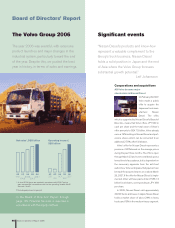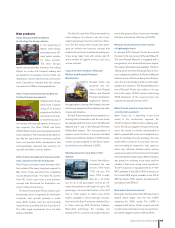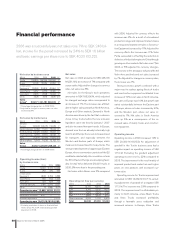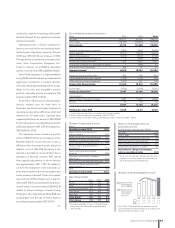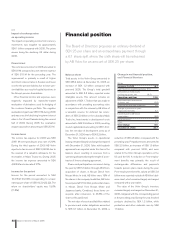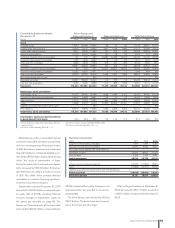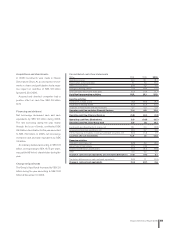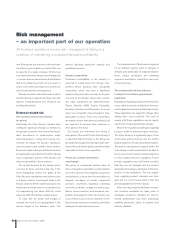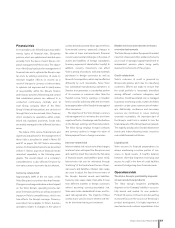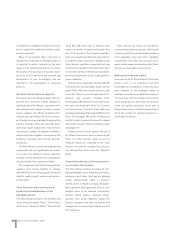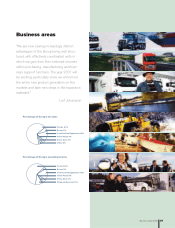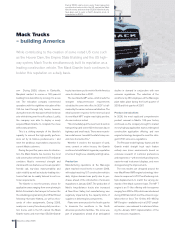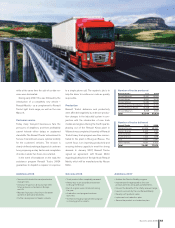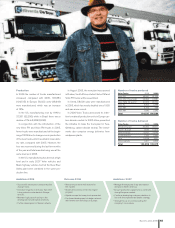Volvo 2006 Annual Report Download - page 60
Download and view the complete annual report
Please find page 60 of the 2006 Volvo annual report below. You can navigate through the pages in the report by either clicking on the pages listed below, or by using the keyword search tool below to find specific information within the annual report.
Risk management
– an important part of our operation
All business operations involve risk – managed risk-taking is a
condition of maintaining a sustained favorable profi tability.
involves adjusting production capacity and
operating expenses.
Intense competition
Continued consolidation in the industry is
expected to create fewer but stronger com-
petitors. Volvo’s products face substantial
competition, which may have a significant
impact on the prices Volvo receives for its prod-
ucts and on the Group’s future sales volume.
Our major competitors are DaimlerChrysler,
Paccar, Navistar, MAN, Scania, Caterpillar,
Komatsu, Cummins and Brunswick. In recent
years, new competitors have emerged in Asia,
particularly in China. These new competitors
are mainly active in their domestic markets, but
are expected to increase their presence in
other parts of the world.
Our brands are well-known and strong in
many parts of the world. For the Volvo Group, it
is important that all brands in the Group are
developed and supported. Strong brands com-
bined with an attractive product portfolio make
it possible for Volvo to be competitive.
Prices for commercial vehicles
may change
The prices of commercial vehicles have, at
times, changed considerably in certain markets
over a short period. This instability is caused by
several factors, such as short-term variations in
demand, shortages of certain component
products, uncertainty regarding underlying
economic conditions, changes in import regu-
lations, excess inventory and increased com-
petition. Overcapacity within the industry can
occur if there is an economic downturn in the
Group’s major markets or worldwide, potentially
leading to increased price pressure.
The financial result of the business depends
on our ability to quickly react to changes in
demand and particularly to adapt production
levels, reduce production and operating
expenses, and deliver competitive new prod-
ucts and services.
The commercial vehicles industry
is subject to extensive government
regulation
Regulations regarding exhaust emission levels,
noise, safety and levels of pollutants from pro-
duction plants are extensive within the industry.
These regulations are subject to change, often
making them more restrictive. The costs to
comply with these regulations can be signifi-
cant for the commercial vehicles industry.
Most of the regulatory challenges regarding
products relate to reduced engine emissions.
The Volvo Group is a significant player in the
commercial vehicle industry and the world’s
largest producer of heavy-duty diesel engines.
The product development capacity within the
Volvo Group is well consolidated to be able to
focus resources for research and development
to meet tougher emission regulations. Future
product regulations are well known, provided
that they are not changed and the product
development strategy is well tuned to the intro-
duction of new regulations. The new regula-
tions regarding product emissions are strin-
gent, but our current assessment is that they
are manageable for the Volvo Group.
Volvo has had production facilities in numer-
ous countries worldwide for many years. A
worldwide production standard for environ-
mental performance has been introduced,
enabling production plants to achieve best
industry standard.
>>> Risk may be due to events in the world and
can effect a given industry or market. Risk can
be specific to a single company. At Volvo we
work daily to identify, measure and manage risk
– in some cases we can influence the likelihood
that a risk-related event will occur. In cases in
which such events are beyond our control, we
strive to minimize the consequences.
We have chosen to classify the risks to which
the Volvo Group is exposed into three main cat-
egories: External-related risk, Financial risk
and Operational risk.
External-related risk
The commercial vehicles industry
is cyclical
Historically, the Volvo Group’s markets have
undergone significant changes in demand as
the general economic environment has fluctu-
ated. Investments in infrastructure, major
industrial projects, mining and housing con-
struction all impact the Group’s operations,
since its products are central to these sectors.
Economic trends in Europe and North America
are particularly important for the Volvo Group,
since a significant portion of the Group’s net
sales are generated in these markets.
The cyclical demand for the Group’s prod-
ucts has, at times, restricted, and may in the
future temporarily restrict, the ability of the
Volvo Group to manufacture and deliver orders
in a timely manner. A prolonged delay in the
Group’s ability to deliver ordered products on a
timely basis at a time when its competitors are
not experiencing the same difficulty could
adversely affect the Group’s market shares.
To cope with the peaks and troughs in
demand, we need to act appropriately in the
various stages of the business cycle. This
56 Board of Directors’ Report 2006


